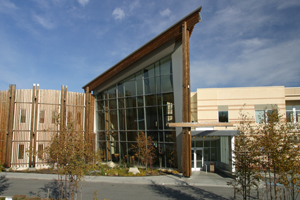
The Alaska Native Medical Center – if I lived in Anchorage this is where I would get all of my health care
This is the time of year when people get to choose a new health insurance plan. It happens every year at this time, and this year, because of the Affordable Health Care Act, more people are becoming aware of just what insurance will cover, what it won’t cover, and everyone has an opinion about it.
But if you are like the vast majority of Americans, you have no idea what the insurance plan covers, doesn’t cover, and don’t know if the insurance company will keep your doctor in its network, or toss them out.
So here are a few things to really look for when choosing an insurance plan and a doctor and a hospital. So lets start with that shiny new hospital next door.
(a) Check out Cafeteria
For most hospitals a cafeteria is a place where they lose money. But for some, the hospital cafeteria is a place of healing, where they make delicious and healthy meals for their patients. If you go to the cafeteria and they are peddling the food that got you there- think again.
(b) Teaching or Non-teaching hospital
I’ve been at both – I’ve run a surgery training program, and been in hospitals where there are no residents. Some love a teaching hospital because you get some great minds who will work on you. Teaching hospitals are great for obscure diagnosis and treatments, for common things, and common problems – maybe not so much.
(c) The Nurses
In the middle of the night, when a patient is having a problem who do I want checking that patient – an experienced nurse or an intern or a hospitalist. Give me an experienced nurse any day of the week. They have seen more disease than any intern, they have had more experience than most hospitalists. They know when a patient looks well, or ill. Find a hospital that values its nurses and keeps them.
(d) Hospital ratings
There are a lot of ways of looking at hospital ratings. The problem with people who rate them is they either have a bad experience, or a great one – and it doesn’t help you much. People go to hospitals because they are sick, and bad things will happen. People will die, people will have complications,and people can be sicker than they know.
Here is what hospitals can be graded for: (a) bedsores – preventable from the hospital. The more of these that the hospital has translates to the less a patient is seen and moved (b) hip fractures after surgery – patients will fall after surgery, it happens even in the best of hospitals – and they fracture their hips. But there should not be too many of those (c) Foreign bodies left in the patient after surgery – this happens because the nursing team at the hospital was not paying attention – some like to blame the surgeon, but the surgeon is focused on surgery, the operating team is focused on counting and re-counting sponges, instruments, needles.
There are a lot of categories that are viewed by outside grading systems that have no reflection on the outcomes – but they are measured.
Here is what not to look for:
Where the hospital is located.
You may like that a hospital is close to you, and you don’t want to go to the bad part of town, but the best hospitals in the nation are often located in the worst neighborhoods. The University of Chicago, Johns Hopkins, Harborview Hospital – all located in neighborhoods that are not the best – but all are outstanding facilities I would recommend to anyone. There are also “famous” hospitals located in nice neighborhoods that I would never bring my family to.
My favorite hospital – The Alaska Native Medical Center in Anchorage, Alaska. Amazing staff, dedicated physicians, and a governing board that is interested in the health care of its patients. If I lived in Anchorage, Alaska- that is where I would take my family. But it goes together with a great primary care system – SouthCentral Foundation.

Primary care organizations, like South Central Foundation, do more to keep patients out of the hospital, and reduce costs. These are the types of organizations that are best for you and your family
